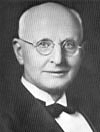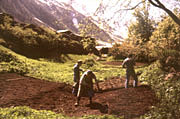The Darwin of nutrition
 "Nutrition and Physical Degeneration" by Weston A. Price, DDS, 1939, 50th anniversary edition 1989, Keats, ISBN 0-87983-502-8
"Nutrition and Physical Degeneration" by Weston A. Price, DDS, 1939, 50th anniversary edition 1989, Keats, ISBN 0-87983-502-8
Weston A. Price discovered what health is made of, and proved it. In the early 1930s Price and his wife ("Mrs Price") travelled more than 100,000 miles to study the diets and health of isolated primitive peoples in Africa, South America, Australia, Polynesia, Europe and northern Canada, at a time when such communities still existed.
Price undertook amazing journeys into the wilds to seek out people "who were living in accordance with the tradition of their race and as little affected as might be possible by the influence of the white man".
Wherever he found them -- regardless of race, diet and climate -- they were a "picture of superb health": they had superb physiques, perfect teeth, no arthritis, no tuberculosis, no degenerative diseases, and they were cheerful, happy, hardy folk.
Weston A. Price
That changed radically when he compared them to other, less isolated groups of the same peoples, charting a catastrophic health decline the closer they got to the "trade foods" produced by industrial society (processed foods grown by synthetic farming methods), in the shape of the "white man's store".
He found it takes only one generation of eating industrialized food to destroy health and immunity.
Price was a good scientist and a thorough investigator and collected an enormous amount of data with thousands of supporting photographs -- his case simply doesn't leave any room for argument. We are all victims. But he leaves us with the promise of regeneration. Thwarted health can be recaptured.
Price's book makes fascinating reading -- it's a great travelogue, full of interest and charm, and essential to understanding the nature of food and health. Price is truly "the Charles Darwin of nutrition".
Steve Solomon has written an extended review of "Nutrition and Physical Degeneration" (like many, reading it changed his life), including a good selection of photographs from the book, online at the Soil and Health Library -- the full text of the book is also online:
Preparing the potato beds in Loetschendal Valley high in the Swiss Alps, spring 1987 -- in 1931 Weston Price found a secluded community here of healthy mountaineers who had no doctor and no dentist, and never needed them. (Keith Addison)
http://www.soilandhealth.org/
For further information see Sally Fallon's excellent and informative website at the Weston A. Price Foundation:
http://www.westonaprice.org/
Two reviews by Sally Fallon -- "Nutrition and Physical Degeneration", with photographs and tables:
http://www.westonaprice.org/nutrition_greats/price.html
Weston A. Price and his work:
http://www.westonaprice.org/book_reviews/nutrition_physical.html
Order "Nutrition and Physical Degeneration" from amazon.com, or from the Price-Pottenger Nutrition Foundation:
http://www.price-pottenger.org/
Article on butter by Weston A. Price, "Are the Activators Revealing The Nature of Life in Health and Disease Including Dental Disease?", Cleveland, Ohio 1932:
http://www.westonaprice.org/archive/archive_weston.html
"Acid-Base Balance of Diets Which Produce Immunity to Dental Caries Among the South Sea Islanders and Other Primite Races" by Weston A. Price:
http://www.price-pottenger.org/Articles/Acid_base_bal.htm
Price's "Letter to his Nieces and Nephews":
http://www.price-pottenger.org/Articles/PriceLetter.htm
"The Skinny on Fats" from "Nourishing Traditions: The Cookbook that Challenges Politically Correct Nutrition and the Diet Dictocrats", by Sally Fallon with Mary G. Enig, PhD., 2nd Edition, 1999, New Trends Publishing, Inc., online at the Weston A. Price Foundation:
http://www.westonaprice.org/know_your_fats/skinny.html
"It sounds like you might have been reading 'Nourishing Traditions,' by Sally Fallon, which has been mentioned on this list several times I think. I finally got it from the library a few weeks ago and was dumbfounded at what I read. Being a nutritionist by training, my thinking about fat and cholesterol was turned upside down! It's a good thing I'm retired, or I'd be in trouble with my boss for not touting the company line!" -- From a letter to the Organic Gardening Discussion List, 8 April 2001.
"The Case for Butter" by Trauger Groh:
http://www.price-pottenger.org/Articles/Case_for_butter.html
See also:
The Medical Testament published by the 31 doctors of the Cheshire Panel Committee in England on March 22 1939, full text online at the Journey to Forever Small Farms Library.
The Saccharine Disease: Conditions caused by the Taking of Refined Carbohydrates, such as Sugar and White Flour by T. L. Cleave, John Wright, 1974, full text online at the Journey to Forever Small Farms Library.
"Nutrition and National Health" by Sir Robert McCarrison, Faber and Faber, 1953, full text online at the Soil and Health Library:
http://www.soilandhealth.org/
"The Wheel of Health: A Study of a Very Healthy People" by G.T. Wrench, Daniel, 1938, reprinted 1960, 1990, full text online at the Journey to Forever Small Farms Library.

